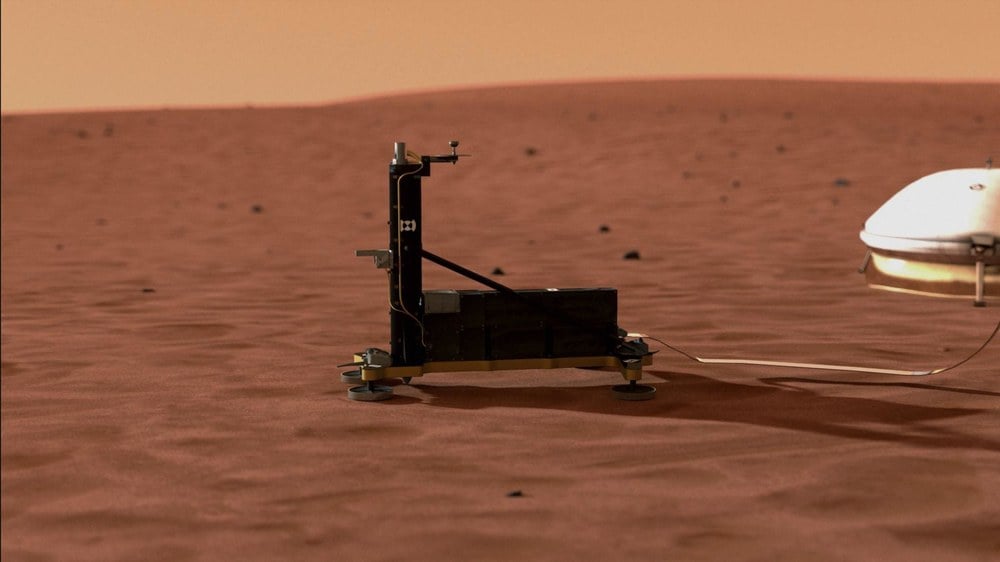On November 26th, 2018, NASA's Interior Exploration using Seismic Investigations, Geodesy, and Heat Transport (InSight) mission landed on Mars. This was a major milestone in Mars exploration since it was the first time a research station had been deployed to the surface to probe the planet's interior. One of the most important instruments InSight would use to do this was the Heat Flow and Physical Properties Package (HP3) developed by the German Aerospace Center (DLR). Also known as the Martian Mole, this instrument measured the heat flow from deep inside the planet for four years.
The HP3was designed to dig up to five meters (~16.5 ft) into the surface to sense heat deeper in Mars' interior. Unfortunately, the Mole struggled to burrow itself and eventually got just beneath the surface, which was a surprise to scientists. Nevertheless, the Mole gathered considerable data on the daily and seasonal fluctuations below the surface. Analysis of this data by a team from the German Aerospace Center (DLR) has yielded new insight into why Martian soil is so "crusty." According to their findings, temperatures in the top 40 cm (~16 inches) of the Martian surface lead to the formation of salt films that harden the soil.
The analysis was conducted by a team from the Microgravity User Support Center (MUSC) of the DLR Space Operations and Astronaut Training Institution in Cologne, which is responsible for overseeing the HP3experiment. The heat data it obtained from the interior could be integral to understanding Mars's geological evolution and addressing theories about its core region. At present, scientists suspect that geological activity on Mars largely ceased by the late Hesperian period (ca. 3 billion years ago), though there is evidence that lava still flows there today.
This was likely caused by Mars' interior cooling faster due to its lower mass and lower pressure. Scientists theorize that this caused Mars' outer core to solidify while its inner core became liquid—though this remains an open question. By comparing the subsurface temperatures obtained by InSight to surface temperatures, the DLR team could measure the rate of heat transport in the crust (thermal diffusivity) and thermal conductivity. From this, the density of the Martian soil could be estimated for the first time.
The team determined that the density of the uppermost 30 cm (~12 inches) of soil is comparable to basaltic sand - something that was not anticipated based on orbiter data. This material is common on Earth and is created by weathering volcanic rock rich in iron and magnesium. Beneath this layer, the soil density is comparable to consolidated sand and coarser basalt fragments. Tilman Spohn, the principal investigator of the HP3experiment at the DLR Institute of Planetary Research, explained in a DLR press release:
"To get an idea of the mechanical properties of the soil, I like to compare it to floral foam, widely used in floristry for flower arrangements. It is a lightweight, highly porous material in which holes are created when plant stems are pressed into it... Over the course of seven Martian days, we measured thermal conductivity and temperature fluctuations at short intervals. " Additionally, we continuously measured the highest and lowest daily temperatures over the second Martian year. The average temperature over the depth of the 40-centimetre-long thermal probe was minus 56 degrees Celsius (217.5 Kelvin). These records, documenting the temperature curve over daily cycles and seasonal variations, were the first of their kind on Mars."
Because the encrusted Martian soil (aka. "duricrust") extends to a depth of 20 cm (~8 inches), the Mole managed to penetrate just a little more than 40 cm (~16 inches) - well short of its 5 m (~16.5 ft) objective. Nevertheless, the data obtained at this depth has provided valuable insight into heat transport on Mars. Accordingly, the team found that ground temperatures fluctuated by only 5 to 7 °C (9 to 12.5 °F) during a Martian day, a tiny fraction of the fluctuations observed on the surface—110 to 130 °C (230 to 266 °F).
Seasonally, they noted temperature fluctuation of 13 °C (~23.5 °F) while remaining below the freezing point of water on Mars in the layers near the surface. This demonstrates that the Martian soil is an excellent insulator, significantly reducing the large temperature differences at shallow depths. This influences various physical properties in Martian soil, including elasticity, thermal conductivity, heat capacity, the movement of material within, and the speed at which seismic waves can pass through them.
"Temperature also has a strong influence on chemical reactions occurring in the soil, on the exchange with gas molecules in the atmosphere, and therefore also on potential biological processes regarding possible microbial life on Mars," said Spohn. "These insights into the properties and strength of the Martian soil are also of particular interest for future human exploration of Mars."
What was particularly interesting, though, is how the temperature fluctuations enable the formation of salty brines for ten hours a day (when there is sufficient moisture in the atmosphere) in winter and spring. Therefore, the solidification of this brine is the most likely explanation for the duricrust layer beneath the surface. This information could prove very useful as future missions explore Mars and attempt to probe beneath the surface to learn more about the Red Planet's history.
*Further Reading: DLR*
 Universe Today
Universe Today


